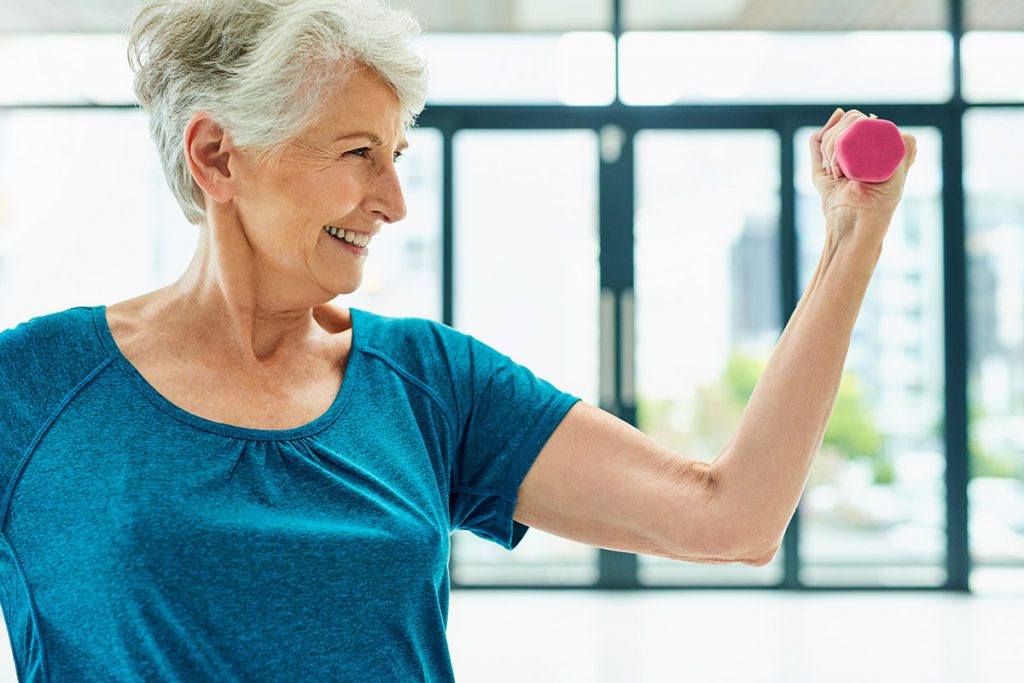Functional Fitness: The SilverSneakers Guide
This type of exercise supports every move you make. Learn how functional fitness can help you maintain your mobility, balance, and range of motion.

Without even making time for exercise, you still work your muscles every day. It happens when you reach for a box on a high supermarket shelf, carry anything heavy, and even when you get out of bed in the morning. But as you get older, you start to lose your strength and range of motion, and you may find it harder to do these things.
Functional fitness focuses on aiding these movements you make in your day-to-day life. When you strengthen the muscles you use for daily activities, you’re less likely to injure yourself and more likely to maintain your independence.
Get and stay fit with SilverSneakers! Choose from dozens of different Community classes, visit a participating fitness location, or view the current schedule of SilverSneakers LIVE online classes.
What is functional fitness?
All fitness has a function. Cardiovascular exercise can boost your heart and lung health, while strength training builds your muscles. Functional fitness is a specific type of exercise approach that improves everyday movement. Functional fitness includes moves such as:
- Squatting
- Lifting
- Pushing
- Pulling
- Carrying
- Stepping up and down
- Balancing
- Walking
- Reaching above your head
- Twisting
This form of fitness works multiple muscle groups at the same time. When you do that, you will improve your coordination and body awareness. You’ll also move side to side and back and forth to increase mobility, balance, and range in your joints.
What are some examples of functional exercises?
These moves below help you improve your ability to do these daily activities:
- Squats: Getting in and out of a chair without using your hands
- Twists and rotation exercises: Turning to grab something behind you or toward someone who’s talking to you
- Step-ups: Climbing stairs, stepping onto or off a curb
- Deadlifts: Moving grocery bags from the trunk of your car to your kitchen counter
- Overhead presses: Reaching to get something from a high shelf
- Lunges: Coming down to one knee to tie your shoe, garden, or clean
- Balancing on one leg: Walking on uneven or slippery surfaces
- Pushups: Going through heavy or revolving doors
- Core exercises: Climbing into and out of bed or the bathtub
Recommended reading: 4 Exercises You Should Do Every Day
What types of equipment do you need for functional fitness?
Functional exercises can be done with just bodyweight, but you can also use equipment to provide more resistance. This includes:
- Hand weights
- Small medicine ball or inflated ball
- Resistance bands or tubing
- Jump rope
If you’re training at home, you can use household items you have on hand, like bottles of water or a sports ball instead of a medicine ball.
SilverSneakers classes offer all the gear you need to complete the functional fitness exercises in class.
Why does functional fitness matter for older adults?
The conventional wisdom “use it or lose it” definitely applies to mobility. For example, if you stop reaching over your head, you may eventually lose the full range of motion in your shoulders. Functional fitness helps your body keep moving properly.
Research in the European Review of Aging and Physical Activity looked at functional fitness for older adults. Researchers found that study participants had significant benefits in muscle strength, balance, mobility, and activities of daily living.
Balance is a big deal as you get older. The better your balance, the less likely you are to take a tumble and injure yourself. Boosting your balance can also have other aging benefits. Research in Frontiers in Aging Neuroscience suggests that the ability to control balance and coordination helps improve memory in older adults.
The results of functional fitness don’t take long to see. A study in the Journal of Geriatric Physical Therapy looked at high-intensity functional training for middle-aged cancer survivors. Researchers found that two sessions per week for eight weeks significantly improved physical function.
What are some easy functional fitness moves for beginners?
There are many simple functional fitness exercises. Not sure where to start? Think about the types of movements that are challenging for you. You might not have a problem balancing on one foot, but maybe you can’t get up from a chair without using your arms. If that’s the case, you should spend more time doing squats than working on your balance.
These basic functional fitness moves can be done at home, or you can do them at the gym if you’re already there taking classes or doing other workouts.
Overhead press. Take two light weights and hold one in each hand, with your palms facing forward. Start with your hands at shoulder height and your elbows bent. Press the weights straight upward, then back down. Repeat 10 times.
Here’s how to Master the Overhead Press. If lifting your arms overhead bothers your shoulder, you can try these shoulder exercises instead.
Weighted squat. Hold a weight with both hands at chest level. Slowly lower yourself down, as if you’re about to sit in a chair and press into your feet to rise back up. If you’re new to squats, you may want a chair behind you for safety. Repeat 10 times.
Here are 4 Ways to Do a Squat.
High-knee balance. Stand near a table or sturdy chair so you can grab onto it if you need to. Keep your shoulders down and relaxed, look straight ahead, and raise one knee up to about hip level or as high as feels comfortable. Focus on putting your weight into the standing leg and foot. Hold for 15 seconds, then switch sides.
Subscribe to our newsletter
It's quick and easy. You could be one of the 13 million people who are eligible.
Already a member? Click to discover our 15,000+ participating locations.
Follow Us
Press play to follow along with SilverSneakers trainer Andi Kwapien as she demonstrates 5 Exercises You Should Do Every Day
Do I need to check with my doctor before trying functional fitness?
It’s always a good idea to check with your doctor before beginning any new exercise program. Some types of exercise can make certain health conditions worse, such as congestive heart failure, COPD, osteoporosis, or type 2 diabetes. If you have an issue like those, it’s important to talk to your doctor before starting any exercise plan.
If you already have a fitness routine and are generally healthy, it may not be necessary to speak to your doctor before adding functional fitness moves to your current routine. Pick a few functional options that seem appealing to you and work on the parts of your body you’d like to strengthen even more.
Be sure to pay attention to how you feel when you move. Your muscles should feel challenged, and you might get tired during your workout. But if you’re feeling any pain, that’s a sign you need to dial it back or switch to another exercise. If the pain continues, check in with your doctor in case there’s an underlying issue.
Like any kind of exercise, the more you do it, the easier it will get. Plus, you’ll be making your daily life easier and building your skills for other fitness endeavors — hello, future pickleball champ!
See Our Sources:
Functional training in general: ACSM Health & Fitness Journal. (2017) Ten Nice-to-Know Facts About Functional Training
Exercise examples: NASM. (2021) Functional Training: Compound Workouts for Fitness
Functional training and aging: European Review of Aging and Activity. (2014) Systematic review of functional training on muscle strength, physical functioning, and activities of daily living in older adults
Balance and coordination: Frontiers in Aging Neuroscience. (2019) The Effect of Balance and Coordination Exercises on Quality of Life in Older Adults: A Mini-Review
Improved function: Journal of Geriatric Physical Therapy. (2021) High-Intensity Functional Training Shows Promise for Improving Physical Functioning and Activity in Community-Dwelling Older Adults: A Pilot Study
Take Your Favorite SilverSneakers Classes Online!
SilverSneakers members can access live fitness classes and wellness workshops through SilverSneakers LIVE. See the latest schedule and RSVP for classes here.
Not a member? If you have a Medicare Plan, it may include SilverSneakers — at no additional cost. Check your eligibility instantly here.
Not eligible for SilverSneakers? You can still get 200+ free SilverSneakers On-Demand videos and stay in touch with us by creating your online account.





